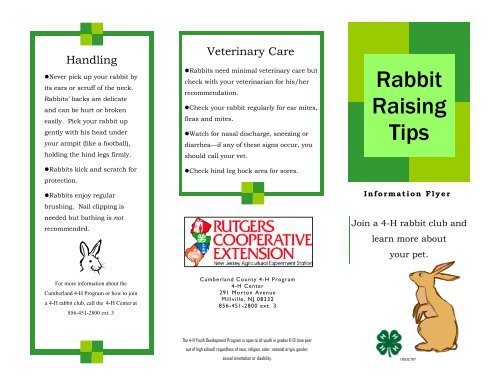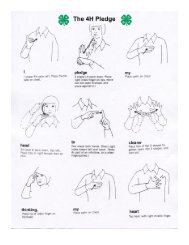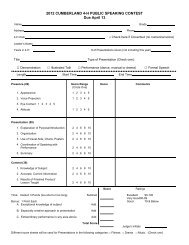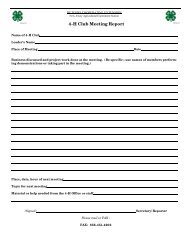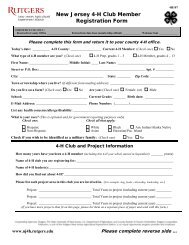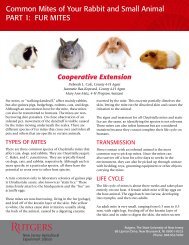Rabbit Care Flyer (Read-Only) - cumberland county 4-h.
Rabbit Care Flyer (Read-Only) - cumberland county 4-h.
Rabbit Care Flyer (Read-Only) - cumberland county 4-h.
- No tags were found...
Create successful ePaper yourself
Turn your PDF publications into a flip-book with our unique Google optimized e-Paper software.
Handling•Never pick up your rabbit byits ears or scruff of the neck.<strong>Rabbit</strong>s’ backs are delicateand can be hurt or brokeneasily. Pick your rabbit upgently with his head underyour armpit (like a football),holding the hind legs firmly.•<strong>Rabbit</strong>s kick and scratch forprotection.•<strong>Rabbit</strong>s enjoy regularbrushing. Nail clipping isneeded but bathing is notrecommended.Veterinary <strong>Care</strong>•<strong>Rabbit</strong>s need minimal veterinary care butcheck with your veterinarian for his/herrecommendation.•Check your rabbit regularly for ear mites,fleas and mites.•Watch for nasal discharge, sneezing ordiarrhea—if any of these signs occur, youshould call your vet.•Check hind leg hock area for sores.<strong>Rabbit</strong>RaisingTipsInformation <strong>Flyer</strong>Join a 4-H rabbit club andlearn more aboutyour pet.For more information about theCumberland 4-H Program or how to joina 4-H rabbit club, call the 4-H Center at856-451-2800 ext. 3Cumberland County 4-H Program4-H Center291 Morton AvenueMillville, NJ 08332856-451-2800 ext. 3The 4-H Youth Development Program is open to all youth in grades K-13 (one yearout of high school) regardless of race, religion, color, national origin, gender,sexual orientation or disability.18USC707
Feeding•Feed your rabbit commerciallypreparedrabbit pellets. They areformulated especially for rabbitsand will provide all of the necessarynutrients for your rabbit. Followfeeding directions on the label.•Your rabbit should have clean,fresh water available at all times.Water bottles or heavy crocks areideal. Be careful in the winter thatthe water does not freeze.•DO NOT feed your rabbit iceberglettuce. Snacks of carrots, yogurtdrops, popcorn, saltines andpapaya are a great for your pet. Ahandful of timothy hay is healthyfor your pet, also.•A small salt lick is fine althoughnot necessary if you feed yourrabbit a commercially preparedfeed.•Applewood chew sticks arehelpful in wearing down yourrabbit’s teeth.Housing•A rabbit should be housed in a wire cageat least 3 ft. x 3 ft. (larger cages are neededfor larger breeds) that droppings can fallthrough easily. A wooden or plastic hockboard should be provided for the rabbit tosit on to prevent sore hocks.•If your rabbit is housed outside, a draftfreehutch or house must be provided toprotect against the elements.•Glass tanks are not good housing forrabbits because the lack of airflow causesrespiratory problems.•Never house more than one rabbit percage as gender can be difficult todetermine and rabbits multiply rapidly!•Never release your pet rabbit into thewild...they will not survive.•Your rabbit should be housed out ofdirect sunlight, preferably in acool shady spot.•<strong>Rabbit</strong>s make good housepets and can be litter boxtrained; however, you mustguard against them chewingelectrical wires and cords.•Outdoor pets will appreciatea soda bottle filled with water,frozen and placed in their cageduring extremely hot weather.You rabbit will lay against it tocool off.BreedsResearch rabbit breedscarefully. Some breeds canget up to 14 lbs. and will needlarger housing. Also, somebreeds are quieter and friendlierthan others.


